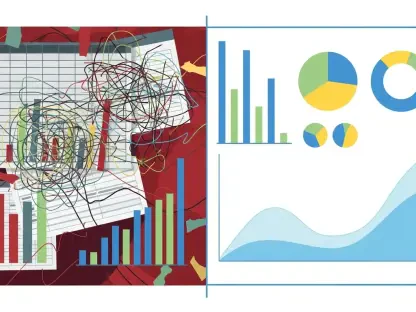The financial sector stands at a critical juncture where the relentless pace of regulatory updates threatens to overwhelm even the most prepared firms, but a groundbreaking solution is emerging through Generative Artificial Intelligence (GenAI). In an industry defined by constant shifts in laws and guidelines, particularly in areas like anti-money laundering (AML) and data privacy, staying compliant is a daunting task. Traditional methods, often reliant on manual processes and outdated tools, struggle to keep up, leaving organizations exposed to penalties and reputational risks. GenAI is stepping into this fray as a transformative force, automating cumbersome tasks and delivering insights with remarkable speed. This technology promises to redefine how financial and FinTech firms manage regulatory change, turning a persistent burden into a strategic opportunity. By exploring insights from industry leaders and cutting-edge applications, this article delves into the profound impact of GenAI on compliance workflows. It examines the benefits of automation, the practical uses across diverse scenarios, and the challenges that must be addressed to harness its full potential. As regulatory landscapes grow more complex, understanding how GenAI can streamline processes while maintaining accuracy and accountability becomes essential for any forward-thinking firm.
Navigating the Regulatory Maze
The challenge of managing regulatory change in finance is a persistent hurdle that has only intensified with the globalization of markets and the rapid evolution of technology. Financial institutions face a barrage of new laws, guidelines, and compliance requirements almost daily, driven by both regional mandates and international standards. Failure to adapt swiftly can lead to severe consequences, including hefty fines, legal repercussions, and damage to a firm’s reputation. This high-stakes environment demands constant vigilance, yet many organizations find themselves ill-equipped to handle the sheer volume and complexity of updates, often resulting in operational disruptions that hinder growth and stability.
Historically, compliance teams have relied on labor-intensive methods to track and implement regulatory changes, spending endless hours manually reviewing updates from regulator websites, poring over newsletters, and updating internal policies by hand. This reactive stance leaves little room for strategic foresight, as teams are perpetually playing catch-up with changes that have already taken effect. The situation is particularly acute in sectors like FinTech, where cross-border operations and innovative business models add layers of regulatory intricacy. GenAI emerges as a vital tool to alleviate these pressures, offering automation that can transform how firms approach compliance, shifting the focus from mere reaction to proactive preparation in an increasingly demanding landscape.
Unleashing Efficiency with GenAI
One of the most compelling advantages of GenAI in regulatory change management lies in its ability to automate repetitive and time-intensive tasks, fundamentally altering the efficiency of compliance operations. Described by industry experts as a “force multiplier,” this technology can handle everything from monitoring regulatory updates in real time to generating concise summaries of complex documents. Where traditional methods might take months to process significant regulatory shifts, GenAI condenses this timeline to mere days, enabling firms to respond with agility. This rapid turnaround not only reduces the workload on compliance teams but also minimizes the risk of falling behind on critical updates, ensuring that organizations remain aligned with the latest requirements.
Beyond speed, GenAI brings a level of customization that sets it apart from conventional regulatory technology solutions. It can filter through vast amounts of data to isolate updates relevant to a specific firm’s operations or jurisdiction, eliminating the clutter of irrelevant information that often overwhelms teams. This tailored approach ensures that insights are actionable and directly applicable, providing a stark contrast to the generic, one-size-fits-all tools of the past. By focusing on what truly matters to an organization’s unique regulatory footprint, GenAI empowers compliance professionals to allocate their time and resources more effectively, enhancing overall productivity and strategic impact in a field where precision is paramount.
Practical Impacts Across Compliance Workflows
The real-world applications of GenAI in regulatory change management are extensive, demonstrating its versatility in addressing a wide array of compliance challenges within the financial sector. From real-time monitoring of regulatory updates to triaging alerts, GenAI is being seamlessly integrated into platforms to enhance both speed and accuracy. Compliance teams can now rely on automated systems to flag critical changes as they happen, drastically reducing the lag time between a regulation’s release and a firm’s response. This capability is particularly valuable in high-pressure areas like AML and Know Your Customer (KYC) protocols, where delays can lead to significant vulnerabilities and missed opportunities for risk mitigation.
Additionally, GenAI extends its utility beyond mere monitoring, supporting critical functions such as document analysis, surveillance enhancement, and even internal communication. For example, it can scrutinize marketing materials to ensure compliance with regulatory standards or simulate suspicious transaction patterns to train machine learning models for AML detection. These diverse use cases highlight how GenAI can adapt to various compliance needs, offering solutions that are both innovative and practical. By automating these intricate processes, the technology not only saves time but also improves the quality of outputs, enabling firms to maintain a robust compliance posture while focusing on core business objectives and growth initiatives.
Addressing the Risks of GenAI Adoption
While the benefits of GenAI are undeniable, its integration into regulatory change management is not without significant risks that demand careful consideration. A primary concern is the potential for errors, often termed “hallucinations,” where the technology might misinterpret complex legal texts or produce inaccurate outputs. In a field as precise as compliance, such mistakes can have far-reaching consequences, potentially leading to non-compliance and subsequent penalties. This underscores the importance of maintaining a critical eye on GenAI’s results, ensuring that automated insights are thoroughly vetted before implementation to avoid costly oversights.
Another pressing issue is the risk of bias embedded in the data used to train GenAI models, which can skew interpretations and fail to align with regulatory intent. Industry experts advocate for a “verify and then trust” approach, emphasizing the necessity of human oversight to validate outputs and maintain accountability. Without this safeguard, reliance on flawed or incomplete data could undermine the very benefits GenAI seeks to provide. As firms navigate these challenges, establishing robust frameworks for monitoring and refining GenAI tools becomes essential, ensuring that the technology serves as a reliable partner rather than a source of additional risk in the intricate world of regulatory compliance.
Fostering a Proactive Compliance Culture
GenAI is catalyzing a profound shift in the financial sector by moving compliance from a reactive burden to a proactive advantage. By automating the grunt work of tracking updates and interpreting regulations, this technology frees up compliance teams to engage in strategic planning and advisory roles. Instead of merely responding to changes after they occur, firms can now anticipate regulatory trends and prepare accordingly, reducing exposure to risk. This forward-thinking approach allows organizations to integrate compliance into their broader business strategies, aligning regulatory adherence with long-term growth objectives in a seamless manner.
This cultural shift toward proactive compliance also fosters an environment of confident expansion, where firms can innovate without the constant fear of regulatory missteps. GenAI’s ability to provide real-time insights and tailored recommendations means that compliance teams are no longer bogged down by manual tasks but are instead empowered to drive decision-making with clarity and foresight. As a result, compliance evolves from a function of damage control into a cornerstone of business resilience, enabling organizations to navigate complex regulatory landscapes with greater assurance. This transformation underscores GenAI’s potential to redefine not just processes, but the very mindset with which firms approach regulatory challenges.
Regulators’ Evolving Stance on GenAI
Regulators are demonstrating an increasingly open attitude toward the use of GenAI in compliance, provided that its deployment adheres to principles of responsibility and transparency. Their primary concern lies not with the technology itself, but with the outcomes it produces, encouraging firms to innovate as long as accuracy and accountability remain intact. This supportive stance is evident in the willingness of regulatory bodies to engage in dialogue through initiatives like office hours and innovation forums, creating a collaborative space where technology and oversight can coexist effectively.
Guiding this responsible adoption are frameworks such as the EU AI Act and the NIST AI Risk Management Framework, which provide clear benchmarks for ethical and effective use of AI tools. These guidelines ensure that firms leveraging GenAI align with broader standards of governance, protecting consumers while exploring the technology’s benefits. This evolving regulatory perspective signals a promising future where technology and compliance can advance hand in hand, fostering an environment of trust and innovation. As regulators continue to refine their approaches, firms adopting GenAI are encouraged to prioritize transparency, ensuring that automated solutions enhance rather than complicate the regulatory ecosystem.
Building a Future of Balanced Innovation
Looking back, the journey of integrating GenAI into regulatory change management revealed a landscape of immense potential tempered by the need for careful stewardship. The technology proved its worth by automating tedious compliance tasks, interpreting complex legal texts, and enabling proactive strategies that kept firms ahead of regulatory curves. Its diverse applications, from AML detection to real-time monitoring, demonstrated a versatility that reshaped how financial institutions approached their obligations, turning compliance into a strategic asset rather than a persistent challenge.
Moving forward, the focus shifts to actionable steps that balance innovation with oversight. Firms are encouraged to invest in robust human-in-the-loop systems to validate GenAI outputs, ensuring accuracy in high-stakes environments. Collaboration with regulators becomes a priority, leveraging frameworks like the EU AI Act to align technological advancements with ethical standards. Additionally, fostering specialized training for compliance teams emerges as a key consideration, equipping professionals to tailor GenAI tools to specific needs. As the financial sector continues to evolve, the emphasis on transparency and accountability promises a future where GenAI not only streamlines processes but also reinforces trust, paving the way for sustainable growth and resilience in regulatory management.









